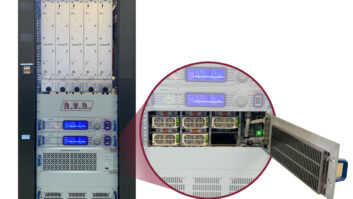An interesting spectrum phenomenon has reared its ugly head over the past few years.
The ubiquity of mobile devices, the desire for faster data speeds, longer battery life and increased features have brought us to later-generation standards such as LTE, which stands for Long Term Evolution.
Originally, it was believed these new standards would be potentially susceptible to harmful interference from adjacent television stations.
As it turns out FM stations instead pose a problem, and in particular their seventh, eighth and ninth iterations.
Say what? Yeah.
SOME BACKGROUND
LTE is built on the GSM and UMTS standards. It was originally proposed a little over 10 years ago in 2004, and was finalized some four years later.
The first publicly available LTE service was launched in Norway and Sweden, which is not surprising given the trademark is owned by the European Telecommunications Standards Institute.
The first LTE phone was available at the beginning of the third quarter of 2010, with its smart cousin appearing on the scene a few months later in February 2011.
The standard has taken the world by storm.
In four short years, the United States has managed to achieve close to 80 percent LTE penetration.
South Korea leads the way at nearly 100 percent — not surprising, given that the first LTE phone and first LTE smartphone were designed and manufactured by a major South Korean company.
Due to the novelty of the design, however, the LTE wireless interface is not compatible with the existing 2G and 3G networks, and as a result, LTE must be run in different spectrum.
TV REPACK REAL ESTATE

This real estate became available during the last television repack, and occupies 698 to 806 MHz, or what used to be television Channels 52 through 69. Many of the frequencies being utilized by the larger carriers are located in portions of the 700 MHz band.
The LTE regions in the 700 and 800 MHz bands reside in a slice of spectrum that includes the seventh, eighth and ninth harmonics of the FM broadcast band.
Even though the harmonics are going to be very low in magnitude, it is important to realize that the LTE received power can be very low, as well.
At the fringe of LTE service, the signal level can be as low as 120 dBm, and still be usable. Because of this, the mobile carriers are looking for FM stations to attenuate their harmonics by more than 100 dB, and are seeking received power level of harmonics in the 110 dBm range.
Attenuation at 100 dB is well in excess of what is required by the commission, which is described in Section 73.317. There we find that emissions must be attenuated by the lesser of 43 + 10 log10(PWatts) below the un-modulated carrier or 80 dB. As it turns out, the crossover point is approximately 5 kW, so TPO values in excess of 5 kW have the more stringent requirement of 80 dBc.
PLUG THE LEAK
Generally, transmitters nowadays will meet those requirements, especially at the RF output.
Of course, transmitters meet those standards because they are designed and constructed to comply with FCC rules, not to mobile phone standards.
The problem is that, most of the time, when this harmonic issue pops up, it is not found at the output, and by extension not transmitted up the pipe to the antenna; usually when this issue is identified it is found to be leakage from the cabinet around door seals, air vents and other points where the metallic structure housing the transmitter has a gap of some kind.
Nautel has published a very good article about this issue and potential solutions online at http://www.nautel.com/support/technical-resources/tips-n-tricks/11-18-2014/. And other, additional informational articles are available through a simple online search.
Hardware cloth, foil and various mesh and screen are all solutions that have worked in plugging the “holes” through which RF leaks.
Of course, care must be taken when employing these solutions to avoid unintentional contact with circuitry, dust accumulation and reduced airflow.
LAST ON, YOU�RE IT
Fortunately, the FM harmonics versus LTE problem tends to be limited to circumstances in which the two types of facilities are co-located or are in very close proximity to each other. Typically, for licensees that are in compliance with its rules, the commission follows a “last on” policy.
Simply speaking, an interference problem that occurs is usually the responsibility of the last licensee to come to the site or the last one to make major changes.
In a situation where new LTE infrastructure is built out near an existing FM station, the mobile carrier typically would have the responsibility of solving the problem, if the FM is operating according to the rules.
However, even though the carrier would have to fix the problem, it does not absolve the FM from cooperating with them.
In the event your FM station gets builtout after LTE is already established at a site, you could consider a preventive measure, such as installing the transmitter in a screen room. It’s the most brute-force solution, and the most costly, but it may be necessary if your station is “last on.”
It is important to know whether a problem really exists before taking time and using resources to solve it.
The reality is not all FM frequencies are potentially problematic for LTE operations.
Additionally, FM stations are generally not problematic for the LTE downlink frequencies, only the uplink, or those from the handset to the site.
FM frequencies from 99.9 to 102.3 appear to be most problematic in terms of the seventh harmonic; for the eighth harmonic, 87.9 to 89.5 and 97.1 to 98.3 look to be problematic in the 700 MHz Band; and, 101.7 to 106.1 may be an issue in the 800 MHz bands. The 800 MHz bands also may have ninth harmonic issues with 90.5 to 94.3 MHz.
If your frequency does not fall in one of those ranges, you are not necessarily out of the woods — that would depend on how the public safety licenses are assigned in your area.
If you are contacted by one of the carriers, do not ignore their communication; engage them, but do not take any of their information or data for granted.
It is always a good policy in a potentially contentious situation to make the necessary measurements jointly, with both parties present. This way, both sides are kept honest, and more importantly, are protected from each other, and in some cases from themselves.
Of course, document everything, and if there is any question run it by your consultant — or better yet, have them be present for the measurements.
WHOSE SIDE ARE YOU ON, ANYWAY?
Sometimes the carriers will exhibit more bravado than is necessary. The initial contact often seems to be a thinly veiled threat to notify the commission.
(I suppose this is understandable, considering that from their perspective, the FM station is impinging on their turf.)
Most of the time, however, such a full-frontal attack is unnecessary — especially if you discover the issues have been an ongoing problem for months.
While the rules and the timeline may totally be on your side, it is important to realize that Congress has codified that wireless phones are acceptable emergency communications devices. As a result, the cell carriers do have a certain degree of leverage.
Remember also that about half of the commissioners, as well as some current and former members of the staff, are less interested in broadcasting than broadband.
In the end, spectrum is a finite resource with increasing and competing pressures. These pressures sometimes manifest themselves in odd ways.
Although the LTE issue is not one of our doing, it is one where cooperation is required. It is also one that may become more prevalent in the future.












